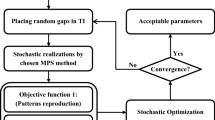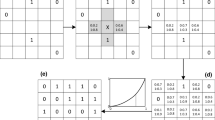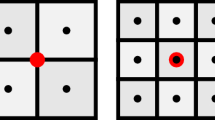Abstract
In many geoscience applications, the data extracted from environmental variables are very limited. Multiple-point geostatistical (MPS) approaches simulate these variables and associated uncertainties at unknown locations by using an exemplar model for the field, called the training image (TI). Existing MPS approaches aim at simulating the field in a way consistent with both available conditional data and TI properties. The inevitably limited size of the training database usually leads to an underestimated variability between different realizations as compared to the variability of the real phenomenon. Furthermore, in over-conditioned regions, patch-based methods often tend to paste the same patch in all realizations. In this paper, we suggest an optimization-based approach for MPS simulation that simulates a bunch of realizations simultaneously. In addition to maintaining consistency with both conditional data and TI properties, the proposed method aims at maximizing the variability between different realizations. Our experiments show that the proposed strategy enhances the variability of the realizations to better conform with real variabilities. The idea of targeting variance maximization can potentially be applied to other MPS simulation methods by simulating a bunch of realizations simultaneously with a constraint to avoid similar patterns at the same location in different realizations.


















Similar content being viewed by others
References
Abdollahifard MJ (2016) Fast multiple-point simulation using a data-driven path and an efficient gradient-based search. Comput Geosci 86:64–74. https://doi.org/10.1016/j.cageo.2015.10.010
Abdollahifard MJ, Ahmadi S (2016) Reconstruction of binary geological images using analytical edge and object models. Comput Geosci 89:239–251
Abdollahifard MJ, Faez K (2013) Stochastic simulation of patterns using Bayesian pattern modeling. Comput Geosci 17:99–116
Abdollahifard MJ, Faez K (2014) Fast direct sampling for multiple-point stochastic simulation. Arab J Geosci 7:1927–1939
Abdollahifard MJ, Mariethoz G, Ghavim M (2019) Quantitative evaluation of multiple-point simulations using image segmentation and texture descriptors. Comput Geosci 23:1349–1368
Abdollahifard MJ, Mariethoz G, Pourfard M (2016) Improving in situ data acquisition using training images and a Bayesian mixture model. Comput Geosci 91:49–63
Abdollahifard MJ, Nasiri B (2017) Exploiting transformation-domain sparsity for fast query in multiple-point geostatistics. Comput Geosci 21:289–299
Arpat GB, Caers J (2007) Conditional simulation with patterns. Math Geol 39:177–203
Emery X, Lantuéjoul C (2014) Can a training image be a substitute for a random field model? Math Geosci 46:133–147
Honarkhah M, Caers J (2010) Stochastic simulation of patterns using distance-based pattern modeling. Math Geosci 42:487–517
Hu L, Chugunova T (2008) multiple-point geostatistics for modeling subsurface heterogeneity: a comprehensive review. Water Resour Res. https://doi.org/10.1029/2008wr006993
Kalantari S, Abdollahifard MJ (2016) Optimization-based multiple-point geostatistics: a sparse way. Comput Geosci 95:85–98
Kopf J, Fu C-W, Cohen-Or D, Deussen O, Lischinski D, Wong T-T (2007) Solid texture synthesis from 2d exemplars. In: ACM transactions on graphics (TOG), vol 3. ACM, p 2
Kwatra V, Essa I, Bobick A, Kwatra N (2005) Texture optimization for example-based synthesis. In: ACM transactions on graphics (ToG), vol 3. ACM, pp 795–802
Le Ravalec M, Noetinger B, Hu LY (2000) The FFT moving average (FFT-MA) generator: an efficient numerical method for generating and conditioning Gaussian simulations. Math Geol 32:701–723
Li X, Mariethoz G, Lu D, Linde N (2016) Patch-based iterative conditional geostatistical simulation using graph cuts. Water Resour Res. https://doi.org/10.1002/2015WR018378
Lyon JM, Ward TL (1980) Sequential calculation of the median. Comput Ind Eng 4:31–39
Maharaja A (2008) TiGenerator: object-based training image generator. Comput Geosci 34:1753–1761
Mahmud K, Mariethoz G, Caers J, Tahmasebi P, Baker A (2014) Simulation of Earth textures by conditional image quilting. Water Resour Res 50:3088–3107. https://doi.org/10.1002/2013WR015069
Mariethoz G, Caers J (2014) Multiple-point geostatistics: stochastic modeling with training images. Wiley, Hoboken
Mariethoz G, Renard P, Straubhaar J (2010) The direct sampling method to perform multiple-point geostatistical simulations. Water Resour Res. https://doi.org/10.1029/2008wr007621
Oriani F, Straubhaar J, Renard P, Mariethoz G (2014) Simulation of rainfall time series from different climatic regions using the direct sampling technique. Hydrol Earth Syst Sci 18:3015–3031. https://doi.org/10.5194/hess-18-3015-2014
Peredo O, Ortiz JM (2011) Parallel implementation of simulated annealing to reproduce multiple-point statistics. Comput Geosci 37:1110–1121
Peyré G (2009) Sparse modeling of textures. J Math Imaging Vis 34:17–31
Pourfard M, Abdollahifard MJ, Faez K, Motamedi SA, Hosseinian T (2017) PCTO-SIM: multiple-point geostatistical modeling using parallel conditional texture optimization. Comput Geosci 102:116–138
Rasera LG, Gravey M, Lane SN, Mariethoz G (2019) Downscaling images with trends using multiple-point statistics simulation: an application to digital elevation models. Math Geosci. https://doi.org/10.1007/s11004-019-09818-4
Rezaee H, Marcotte D, Tahmasebi P, Saucier A (2015) Multiple-point geostatistical simulation using enriched pattern databases. Stoch Environ Res Risk Assess 29:893–913
Rezaee H, Mariethoz G, Koneshloo M, Asghari O (2013) Multiple-point geostatistical simulation using the bunch-pasting direct sampling method. Comput Geosci 54:293–308. https://doi.org/10.1016/j.cageo.2013.01.020
Sharifzadehlari M, Fathianpour N, Renard P, Amirfattahi R (2018) Random partitioning and adaptive filters for multiple-point stochastic simulation. Stoch Environ Res Risk Assess 32:1375–1396
Strebelle S (2002) Conditional simulation of complex geological structures using multiple-point. Stat Math Geol 34:1–22
Tahmasebi P (2018) Multiple point statistics: a review. In: Sagar BD, Cheng Q, Agterberg F (eds) Handbook of mathematical geosciences; fifty years of IAMG. Springer, Berlin, pp 613–643
Tahmasebi P, Sahimi M (2016) Enhancing multiple-point geostatistical modeling: 2. Iterative simulation and multiple distance function. Water Resour Res. https://doi.org/10.1002/2015WR017807
Yang L, Hou W, Cui C, Cui J (2016) GOSIM: a multi-scale iterative multiple-point statistics algorithm with global optimization. Comput Geosci 89:57–70
Zhang T, Switzer P, Journel A (2006) Filter-based classification of training image patterns for spatial simulation. Math Geol 38:63–80
Acknowledgements
The authors would like to express their sincere thanks to anonymous reviewers who devoted their time and expertise to improving this paper.
Author information
Authors and Affiliations
Corresponding author
Additional information
Publisher's Note
Springer Nature remains neutral with regard to jurisdictional claims in published maps and institutional affiliations.
Rights and permissions
About this article
Cite this article
Abdollahifard, M.J., Mariéthoz, G. & Mohammadi, H.S. Investigating extreme scenarios with multiple-point geostatistics and variance maximization. Stoch Environ Res Risk Assess 34, 67–85 (2020). https://doi.org/10.1007/s00477-019-01759-y
Published:
Issue Date:
DOI: https://doi.org/10.1007/s00477-019-01759-y




